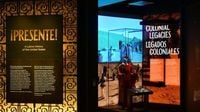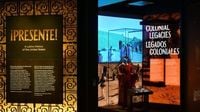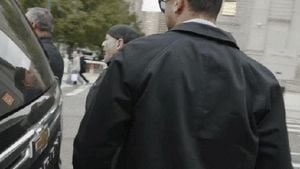The Smithsonian Institution, long celebrated as the nation’s preeminent museum complex, has found itself at the center of a heated political storm after a series of pointed criticisms and policy moves from the Trump administration. In a week marked by escalating rhetoric and official action, the White House has accused the Smithsonian of promoting "ideological" narratives, particularly in its treatment of sensitive subjects like slavery, immigration, and LGBTQ+ history, and has launched an unprecedented review of its exhibitions and programs.
It all began on August 19, 2025, when President Trump took to Truth Social to air his grievances about the Smithsonian’s approach to American history. "The Smithsonian is OUT OF CONTROL, where everything discussed is how horrible our Country is, how bad Slavery was, and how unaccomplished the downtrodden have been — Nothing about Success, nothing about Brightness, nothing about the Future," Trump wrote, adding, "We are not going to allow this to happen, and I have instructed my attorneys to go through the Museums, and start the exact same process that has been done with Colleges and Universities where tremendous progress has been made. This Country cannot be WOKE, because WOKE IS BROKE." (Truth Social, August 19, 2025)
Just days later, on August 22, the White House unveiled a list of 20 Smithsonian exhibits it alleges are "framing historical events through ideological narratives instead of factual evidence," according to reporting from Nexstar Media and NPR. The list, published both on the White House website and in its official newsletter, singles out displays across eight museums, including the National Museum of the American Latino, National Museum of American History, and the National Portrait Gallery.
Among the exhibits criticized: a National Museum of the American Latino display that portrays the U.S. as "stolen land" rooted in colonization; a National Museum of American History depiction of Benjamin Franklin as a slave owner whose scientific achievements were "enabled by the social and economic system he worked within"; and an art installation showing migrants watching July 4 fireworks through an opening in the U.S.-Mexico border wall, which reportedly claims that America’s founders "feared non-white immigration." The administration also took aim at the American History Museum’s "LGBTQ+ History" exhibit and a separate display on the 50th anniversary of Title IX that focuses on transgender athletes. Notably, President Trump had signed an executive order earlier in February barring transgender women from competing in women’s sports, underscoring the administration’s stance on the issue.
The White House’s actions did not stop at public criticism. Letters were sent to the directors of eight Smithsonian museums, including the National Museum of American History, National Museum of Natural History, National Museum of African American History and Culture, National Museum of the American Indian, National Air and Space Museum, Smithsonian American Art Museum, National Portrait Gallery, and Hirshhorn Museum and Sculpture Garden. These institutions were given 120 days to submit their current and future exhibition plans, social media content, and other materials for a comprehensive review. The stated goal: to bring the Smithsonian in line with President Trump’s "historical vision" ahead of the United States’ 250th anniversary celebrations. The administration directed museums to replace "divisive or ideologically driven language with unifying, historically accurate and constructive descriptions." (NPR, August 22, 2025)
This sweeping review has drawn sharp reactions from both within and outside the art world. Artists, historians, and museum professionals have voiced concerns about the potential for censorship and the chilling effect on creative and scholarly expression. Rigoberto A. González, whose painting "Refugees Crossing the Border Wall into South Texas" was singled out by the White House for "commemorating the act of illegally crossing" the border, told NPR he was initially shocked but ultimately "a little bit glad" to have provoked a response. "My work is political, and that painting in particular was questioning the anti-immigrant sentiment of the time. So I'm glad that it got a response from a presidency that is very clearly going anti-immigration," González said. He likened the administration’s list to the "degenerate art" exhibitions of 1930s Germany, where the Nazis targeted artists whose work did not align with their ideals.
Howard University professor and author Ibram X. Kendi was also named in the White House newsletter, labeled as a "hardcore woke activist." Kendi’s book "How to Be an Anti-Racist" has been featured at the National Museum of African American History and Culture. Responding to the label, Kendi told NPR, "Those of us who study racism, who engage in rigorous research to try to explain what racism is have been typically described as activists, as opposed to what we are: scholars and intellectuals using research and analysis to try to present the truth." He argued that the administration’s strategy is to discredit scholars and distract from their scholarship, adding, "It's a way to make me into this boogey-person who should not be taken seriously."
Other artists and scholars have expressed similar apprehensions. Brooklyn-based artist Patricia Cronin, whose "Memorial to a Marriage" is part of the National Portrait Gallery’s permanent collection, worries that the White House’s actions could silence museums and erase marginalized histories. "Part of this whole censorship is to erase our history, but also erase our lives," Cronin said, highlighting the broader implications for artists whose work reflects the complexities of American society.
Art historian Richard Meyers of Stanford University compared the current climate to the McCarthy era and the culture wars of the late 20th century, recalling political battles over controversial works like Robert Mapplethorpe’s photographs and Andres Serrano’s "Piss Christ." Meyers warned that the worst kind of censorship is self-censorship, where artists stifle their own voices out of fear. "It's becoming very difficult to know exactly what is happening, who is making these decisions, how the art is being treated and at what point is it censorship?" he asked.
While the Smithsonian’s press office declined to comment on the White House list, the institution reiterated in June 2025 its commitment to remaining "free from political or partisan influence." Yet, the administration’s review and its calls for "alignment" with presidential directives have left many in the museum community wary of what the future may hold.
Outside the art world, the Trump administration’s stance has found support among some conservative commentators and organizations. The Federalist, a right-leaning online magazine, published an article accusing the Smithsonian of "anti-American propaganda," and the Heritage Foundation previously criticized the Latino exhibit as a "disgrace" to American history. These voices argue that museums should present a more "unifying" and "patriotic" narrative, one that emphasizes national achievements and optimism.
On the other hand, Black historians and community leaders have challenged the administration’s push to downplay the brutal realities of slavery and racial injustice. Toni Draper, publisher of the Afro-American Newspaper, wrote in an op-ed for Afro.com, "Just as the Holocaust is remembered in all its brutality, so must America reckon with the truth of chattel slavery, Jim Crow and racial terror. Anything less is historical erasure, a rewriting of facts to make the nation appear more palatable." She insisted, "History is not meant to comfort — it is meant to confront. And only in confrontation do we find the lessons that lead us forward."
As the Smithsonian’s 120-day review period unfolds, the nation’s cultural institutions are grappling with questions of historical accuracy, ideological influence, and the role of museums in a divided society. For artists, scholars, and audiences alike, the stakes feel higher than ever.





